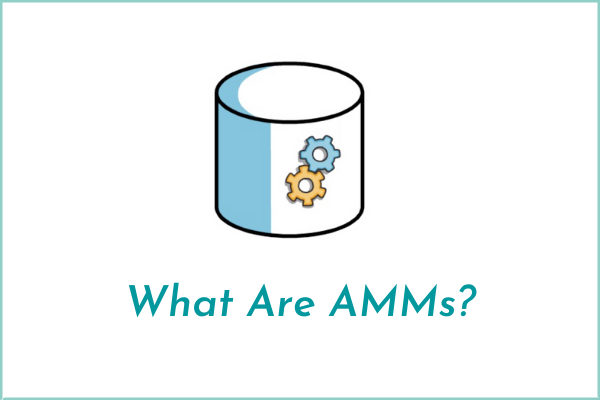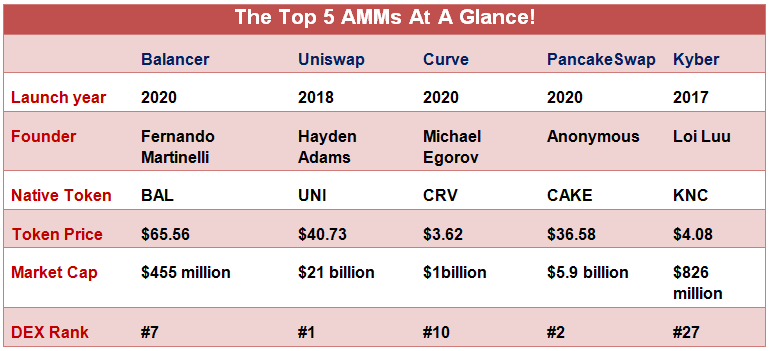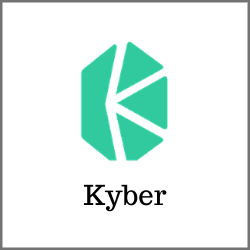In this post, I explained AMMs (Automated Market Makers) in detail.
Most of the success in the DeFi space can be credited to AMMs.
And if that does not make sense to you, don’t worry.
As you read on, you will learn what AMMs are, how they work, and more.
Let’s jump right in!
Post Summary
- What Are Automated Market Makers?
- Characteristics Of Automated Market Makers
- How AMMs Work
- Top 5 Automated Market Makers
- Pros & Cons Of Automated Market Makers
- What Does The Future Hold For AMMs?
- FAQs
- Conclusion
Happy reading!
1. What Are Automated Market Makers?

Automated Market Makers are decentralized exchanges (DEX) that rely on a mathematical formula to price assets.
Think of it as a robot that sets the prices for the coins available in an exchange.
Only that it is not a robot but an algorithm.
Unlike what happens in a traditional exchange where an order book is used to set prices, AMMs use a pricing algorithm to price assets.
Every AMM has its unique pricing algorithm or mathematical formula.
So, there is no need for a middleman or a counterparty to perform a trade.
And any user of an AMM can create a market thereby decentralizing the platform.
Little wonder why AMMs contribute largely to the success of DeFi.
The idea of AMMs was initiated by Vitalik Buterin, co-founder of Ethereum (ETH).
And the first AMM to go live on the Ethereum blockchain was Bancor (BNT) in 2017.
In the next section, we’ll see the characteristics of an AMM.
Keep reading!
2. Characteristics Of Automated Market Makers
AMMs have these characteristics:
- Liquidity pool
- Constant product formula
- Impermanent loss
- Slippage
Liquidity Pool
A liquidity pool refers to a collection of funds locked in a smart contract.
It facilitates decentralized trading in AMMs.
Users known as liquidity providers (LP) add an equivalent value of two tokens in a pool to create a market.
As a reward for providing their funds, they receive a percentage of the trading fees from the trades that happen in their pool.
This reward is proportional to their share of the total liquidity.
And anyone can be a liquidity provider. Great!
Constant Product Formula
This is the mathematical formula that determines the price of assets in an AMM.
It can take any form and the most popular is:
tokenA_balance * tokenB_balance = k or x * y = k (where k represents a constant).
This constant is the balance of assets in a liquidity pool.
And because it is a constant, it determines the prices of tokens in the pool.
So, the prices of the tokens may vary periodically to achieve this constant.
In other words, when tokenA is bought, its price increases because the number of tokens has reduced whereas the price of tokenB decreases because there are more tokenB in the pool.
Different platforms use different formulas to arrive at this balance.
I hope it’s clear🙂
Impermanent Loss
Another feature of AMMs is impermanent loss.
This refers to a loss incurred by LPs when the price ratio of assets in a liquidity pool changes.
A large shift in the price ratio means a huge loss for the LPs.
Gratefully, this loss can be mitigated if the LP does not withdraw deposited tokens during the price shift.
Once the token prices return to their original value, the loss will disappear.
On the other hand, if an LP withdraws his deposit before the token prices revert, he will suffer loss.
However, the percentage of transaction fees he’ll receive from the pool can cover for the loss. Cool, right?
One way that AMMs prevent impermanent losses is by working with token pairs that have a similar value e.g. stablecoins or wrapped tokens.
That way, the impermanent loss is negligible because the price ratio between the pair stays within a relatively small range.
Slippage
Sometimes, there may not be enough liquidity in a pool to make expected profits.
Such insufficiency leads to a difference between the price at which a token should be sold and the actual price that it is sold at.
This difference is referred to as slippage.
When the ratio of the tokens in the liquidity pool changes by a wide margin, it leads to a large amount of slippage.
To prevent slippage from occurring, AMMs encourage users to add more liquidity to a pool.
Also, a less slippage attracts more volume to the platform. Yay!
In the next section, I described how these platforms work.
Tag along!
3. How AMMs Work

An AMM works by providing trading pairs while removing the need of a counterparty.
Traders interact with a smart contract (liquidity pool) that makes the market for them, and not other traders.
That is to say, trades happen between users and contracts. Nothing like order book or order types.
And the price of assets is determined by a formula as we saw earlier.
Here’s the breakdown of how business is done in an AMM:
- An LP creates a pool say, ETH/DAI
- Traders buy tokens with the trading pair
- Then the price ratio of the tokens adjusts to maintain the balance of the pool.
- And so it goes even as more liquidity is added to the pool.
Interesting, huh?
Let’s see the most popular AMMs in the next section.
Keep reading!
4. Top 5 Automated Market Makers
This table is an overview of the top 5 AMMs based on information from Coinmarketcap.com as of May 7th, 2021.

I briefly described these platforms below…
a. Balancer

Balancer is an AMM that offers programmable liquidity.
It was founded by Fernando Martinelli in 2020. And it is popular for introducing liquidity mining.
Here, users earn an income by leveraging their crypto-asset holdings and adding their tokens to a liquidity pool.
Also, they can create pools with up to eight tokens as well as customize ratios and trading fees for each asset. Super!
Balancer has a governance token called BAL and you can read all about it here.
b. Uniswap

Did you know? Uniswap was the second exchange in the AMM verse.
And it was the first decentralized AMM.
Hayden Adams launched the platform in November 2018.
Uniswap provides near-instant and automated liquidity using the constant formula; x*y = k.
It leverages liquidity providers who deposit two ERC-20 tokens into a pool to support trades.
Then it rewards liquidity providers with a fraction of the trading fees proportionate to their contribution.
Uniswap also has a governance token, UNI, of which early adopters benefited from via a high-profile airdrop in September 2020.
You can read our review of Uniswap to learn more.
c. Curve

Here’s another wave-making AMM.
Curve was launched in January 2020 by Michael Egorov.
It functions as a DEX for stablecoins and provides immediate liquidity for them.
Also, Curve facilitates trades by using liquidity provided by participants.
One advantage of using this platform is a minimized slippage and low trading fees for larger trades.
Its governance token called CRV and both individuals and smart contracts can use this protocol.
Get more details from our review of Curve.
d. PancakeSwap

PancakeSwap is one of the latest DEX in this space and it is making news already.
The platform offers a range of liquidity pools that allow LPs to earn rewards in CAKE and other tokens.
PancakeSwap enables fast transactions and charges low fees for token swap.
Here, traders can swap BEP-20 tokens without stress.
Anonymous developers launched the platform on the Binance Smart Chain in September 2020.
Want to know more? We got you covered. Click here to read our PancakeSwap review.
e. Kyber

Just like Uniswap, the Kyber Network is one of the early comers in this space.
Loi Luu et al founded the platform in 2017.
Kyber operates differently from the AMMs that we have seen so far.
Here, liquidity pools are not open to anyone. They are created either by the developer team or professional market makers.
For the price of the tokens in the liquidity pool; it is gotten through external oracles or via a smart contract.
This enables market makers to have higher control of the pool in volatile periods.
Furthermore, Kyber aggregates liquidity from a wide range of reserves and its native token is KNC.
Learn more about this platform from our Kyber review.
Apart from the 5 platforms above, there are other AMMs including StreetSwap, BakerySwap, SwipeSwap, MDEX, JustSwap, etc.
Let’s see the pros and cons of these platforms in the next section.
Tag along!
5. Pros & Cons Of Automated Market Makers
Pros
i. No KYC
AMMs are decentralized exchanges and as such users do not need to go through the hassle of creating and verifying accounts before they can use the platform.
ii. Reduces Emotional Trading
Participants of AMMs do not suffer from emotional trading.
Liquidity pools are balanced automatically as well as token prices.
Therefore, you only need to choose a pool that contains the token you need and make your trade.
This removes the pressure of watching the market to set profitable orders or fear of losing out on trades.
iii. Ease of launching a new token
AMMs especially Uniswap make it easy for you to launch a new token.
Simply apply to have your token listed, and once it is approved, you can create a liquidity pool with your token.
Sadly, scammers abuse this feature and list fake tokens.
Thus, users must apply caution so that they don’t fall victim.
Do a diligent research before opting for a token you’re seeing for the first time.
iv. No middlemen
These exchanges remove the need for middlemen in cryptotrading.
Without middlemen, trades are completed faster and cost less. Superb!
v. Extra Income
Users can earn extra income from transaction fees when they deposit their tokens in liquidity pools.
I’m sure you like the sound of that.
Cons
- There is a risk of buying fake tokens.
- You may lose money via impermanent loss.
- Since AMMs are decentralized, you may lose funds when you encounter a problem as there is no custodian to hold responsible.
Gladly, the pros outweigh the cons.
Moving on, I expressed my thoughts on the future of AMMs.
Keep reading!
6. What Does The Future Hold For AMMs?
From where I stand, the future looks bright for these exchanges.
Already, AMMs are enjoying massive adoption because interest in DeFi has been on the increase.
Some of the liquidity pools record over $200,000 24hr trading volume on a regular basis. Amazing!
Again, the fact that users can trade and earn while remaining anonymous only makes these platforms more attractive.
And considering that advancement is inevitable in the cryptocurrency space, we can expect more excellent versions of AMMs in the future.
We’re almost done here. Keep reading to find answers to some frequently asked questions.
7. FAQs
Yes you can, with the help of lending platforms like Compound.
For starters, if it is too good to be true then it probably is.
Secondly, ensure that the developer team is not in hiding.
Also, check that the platform has a workable model.
Another option is to look up the exchange on Coinmarketcap and view its market trends.
If you’re satisfied with your findings, then go ahead and use the platform.
Get more ideas from our post on DeFi Scams and how to spot them.
B.T.W
If you want to learn how to trade cryptocurrencies profitably, we have created a perfect course to help you do that.
Enroll in our Cryptocurrency Mastery Course by going to www.ctmastery.com.
You can also join our Telegram community at https://t.me/ctmastery for more information.
8. Conclusion
AMMs are an excellent innovation in the crypto space. They make trading easier, faster, and more profitable.
With growing interest in DeFi, more traders will probably flock to Automated Market Makers.
How about you? Do you think these platforms are worth investing in?
Perhaps, you have used one before? What was your experience?
And, do you know other exchanges that you feel should have made my list of top 5?
Tell me in the comments section, let’s engage.
Meanwhile, hit those SM icons below to share this post with your friends, thank you!



0 Comments